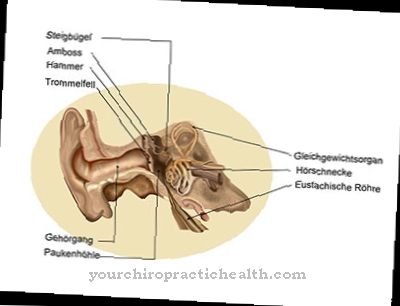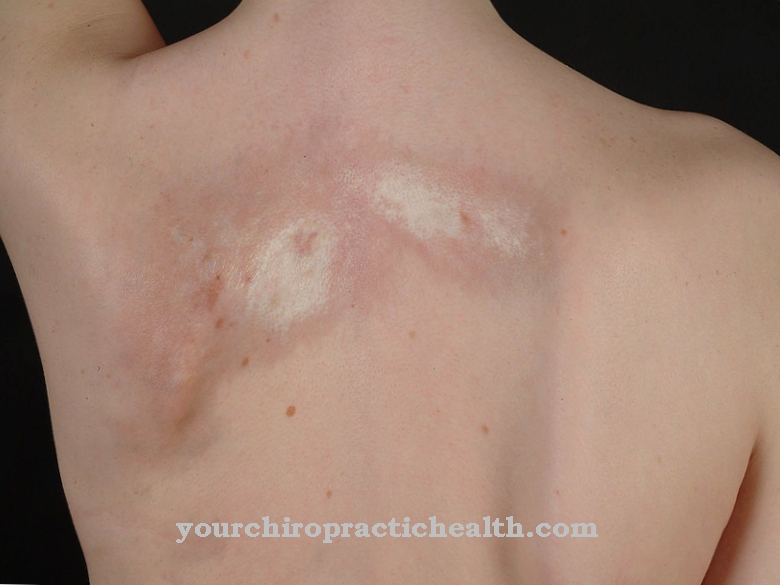Under the DOOR syndrome the doctor understands one of the rarest hereditary diseases worldwide. So far, only 50 cases of the syndrome have been documented, which seem to have a genetic basis and an autosomal recessive inheritance. Treatment of the deformities and retardation is symptomatic at the current time.
What is DOOR Syndrome?

© underdogstudios - stock.adobe.com
DOOR syndrome is a hereditary disease with a low prevalence. The name DOOR syndrome is an acronym that refers to the characteristic symptoms of the disease. The D stands for deafness and thus deafness. O stands in the acronym for osteodystrophy, i.e. bone deformities. The second O stands for onychdystrophy and thus a nail dystrophy. The R refers to the last leading symptom of retardation.
Since treatment-resistant epilepsy also characterizes the syndrome's group of symptoms, the DOORS syndrome is sometimes also referred to. The S stands for Seizures, which means something like epileptic fits. The first description took place in 1970. The French geneticist R. Walbaum is considered the first to describe it. Cantwell coined the term DOOR about five years later. As a hereditary disease, the syndrome has a hereditary basis. So far, only 50 cases have been documented since the first description.
causes
The 50 documented cases of DOOR syndrome suggest a hereditary basis, as they suggest a familial cluster. The DOOR syndrome was therefore observed particularly frequently in siblings and other blood relatives. Inheritance seems to be most likely to be autosomal recessive. Due to the small number of documented cases, the cause has not been conclusively clarified and remains the subject of speculation.
Many scientists assume a metabolic background. An increased concentration of 2-oxoglutaric acid was discovered in the urine and blood of those affected. In addition, a reduced activity of 2-oxoglutaric acid dehydrogenase has now been demonstrated. This enzyme plays a key role in the energy metabolism in particular. Biosynthesis is also dependent on the enzyme. The exact cause of the decreased activity could be a genetic mutation.
Symptoms, ailments & signs
In addition to the eponymous symptoms, patients with DOOR syndrome also suffer from optional symptoms. For example, the mothers of those affected often suffer from polyhydramnios during pregnancy, i.e. increased amniotic fluid. The patients themselves can also suffer from abnormal facial features, such as an extremely large nose.
There may also be detectable changes in the organs. Thumbs that have changed finger-like are also often found on those affected. The same is true for various visual impairments and peripheral neuropathy. The latter symptom summarizes any disorders of the afferent nerve conduction in the peripheral nervous system.
Many of the patients also suffer from analgesia and are therefore completely insensitive to pain. The severity of the individual symptoms varies from case to case. If epilepsy is accompanied by symptoms, this is usually the treatment-resistant form of the disease. Many more accompanying symptoms are probably conceivable, but have not yet been recorded due to the few cases.
Diagnosis & course
The doctor makes the diagnosis of DOOR syndrome solely on the basis of clinical characteristics. Above all, the mandatory features of hearing loss, bone deformities, nail dystrophy and retardation induce him to make a diagnosis. The clinical picture is relatively characteristic and therefore usually does not require complex differential diagnostics. Only Feinmesser and Zelig described an autosomal recessive syndrome with similar symptoms in 1961.
Only the mental handicap is missing in this syndrome, so that the DOOR syndrome can also be differentiated from it by evidence of the symptoms mentioned in the acronym. The doctor uses X-ray imaging to demonstrate the bone deformities. The prognosis of the patients varies greatly.
Life expectancy can be limited to infancy, but it can just as easily remain relatively unrestricted. Organic manifestations in particular have an unfavorable influence on the prognosis. Treatment-resistant epilepsy can also have a negative effect on the prognosis in individual cases.
Complications
There are many different complications associated with DOOR syndrome that cannot be predicted. This is mainly the case because the DOOR syndrome is one of the rarest diseases in the world. In most cases, however, there is mental retardation.
The person concerned cannot think and speak clearly. Also, trains of thought are incomprehensible, so that a mental handicap occurs. This has a negative effect on the life and everyday life of the patient and can lead to depression. These symptoms are also aggravated by the hearing loss, which makes everyday life just as difficult.
Most of the patients are dependent on the help of other people. The DOOR syndrome can have unusual facial features, which is why children in particular are teased and bullied. This also leads to psychological complaints. Unfortunately, no treatment for the DOOR syndrome is currently possible.
However, the symptoms can be treated so that, for example, the abnormal facial features can be operated on. Appropriate medication can be used for epileptic seizures. If the DOOR syndrome causes malformations in the organs, transplants can be carried out. Whether or not there are complications depends heavily on the treatment method. However, the affected person has to live with the DOOR syndrome their entire life.
When should you go to the doctor?
As a rule, only symptomatic treatment is possible with DOOR syndrome. For this reason, the doctor should always be consulted if the person concerned suffers from symptoms due to the DOOR syndrome, which in most cases are already congenital. The children suffer from significant visual disturbances and possibly also from damage to their hearing. In order to guarantee a normal development of the child, these restrictions should be removed from an early age.
A doctor should always be consulted if there are other symptoms of paralysis. Various malformations or malformations should also be examined. In many cases, these can then be treated with surgery. Since the symptoms themselves can vary widely, children in particular should take part in regular medical examinations.
As a rule, the diagnosis of DOOR syndrome can be made by a pediatrician or a general practitioner. Certain examinations that could indicate the DOOR syndrome are also possible during pregnancy. However, it is not possible to prevent the DOOR syndrome.
Doctors & therapists in your area
Treatment & Therapy
Since only 50 cases of the DOOR syndrome have been documented so far and the syndrome is one of the rarest diseases, research into suitable therapy options is still in its infancy. Another problem is that the primary cause for the complex of symptoms has not yet been established. Since no cause has been established, no causal treatment can exist.
For these reasons, the syndrome has so far been regarded as an incurable hereditary disease and is only treated symptomatically. In some cases, the hearing loss can be compensated for with implants. Some bone deformities can be treated surgically. A number of anti-epileptic drugs are available for epileptic seizures. However, most patients hardly respond at all to conservative therapy with these drugs.
Organic malformations must be treated surgically and, if severe, may require a transplant. Mental retardation can be counteracted through early intervention. The enzymatic activity can nowadays be influenced by administering the enzyme.
Whether this procedure promises success for patients with DOOR syndrome, however, remains a largely unanswered question and cannot be answered simply on the basis of the few case documentation. If a genetic mutation is recognized as the cause of the syndrome in the future and the gene therapy approaches reach the clinical phase by then, the disease can under certain circumstances be treated by gene therapy and thus cured.
Outlook & forecast
The DOOR syndrome can only be treated symptomatically as it is a genetic disease. A causal therapy is therefore not possible.
If there is no treatment, those affected suffer from considerable visual problems and various malformations all over the body. The malformations can be very different and in any case limit the patient's everyday life. Likewise, the patients cannot feel any pain, which can lead to severe injuries or incorrect assessments of dangers. Furthermore, some nerve tracts are damaged, so that sensitivity disorders can occur. The child's development is also considerably delayed and restricted by the symptoms.
Since the treatment can only take place symptomatically, only the individual symptoms are alleviated. With the help of medication, the epileptic seizures can be suppressed. Various malformations require surgical intervention. The visual problems can also be alleviated, so that complete blindness is avoided. This also increases the patient's life expectancy. In many cases, those affected and their relatives or parents are dependent on additional psychological treatment, as it is not uncommon for depression and other psychological disorders to occur.
prevention
Since the causes of the DOOR syndrome are not definitely known, the complex of symptoms cannot yet be prevented. Genetic counseling in family planning can still be useful in families with a known case of the syndrome.
Aftercare
In the case of the DOOR syndrome, there are usually no follow-up measures available to the person affected, so that the patient is always dependent on medical treatment. Since this disease is a hereditary disease, it cannot be completely cured, so that the person affected is usually dependent on lifelong therapy. If you want to have children, genetic counseling can also be carried out to prevent this disease from occurring again.
The earlier a doctor is consulted, the better the further course of the disease will usually be. The treatment of the DOOR syndrome is done by taking medication.Those affected should always ensure the correct dosage and regular intake of the medication so that the symptoms can be alleviated.
In the event of an epileptic fit, an emergency doctor should be called immediately or a hospital should be visited directly. Due to the illness, those affected are often dependent on the support of their own family or friends, although they also need support in their everyday life. Contact with other sufferers of the syndrome can also be very useful, as this often leads to an exchange of information.
You can do that yourself
The DOOR syndrome is an extremely rare disease, the cause of which has not yet been treated. Still, there are some treatment options that can help relieve symptoms.
Those affected can support the medical treatment through early support and prudent behavior in everyday life. Mental retardation can be counteracted by therapeutic measures. Physiotherapy and occupational therapy as well as alternative treatment concepts have proven themselves. Parents of affected children should find out more in a specialist clinic for hereditary diseases and work out an individual therapy together with the specialist. Surgical treatment is required for organic malformations.
After an operation, the patient primarily needs rest and bed rest. The doctor will also recommend diet to aid healing. This usually consists of light foods and plenty of fluids. Stimulants such as alcohol, nicotine or caffeine should be avoided in the first few days after the procedure. In addition, it is important to observe the medical guidelines regarding wound care. The wound must be treated with special ointments so that it heals quickly and there are no wounds left.



























